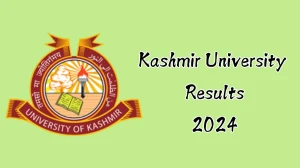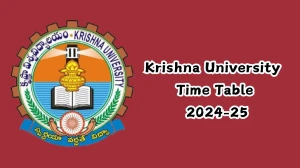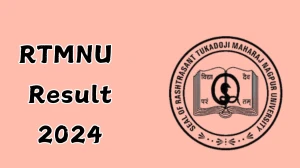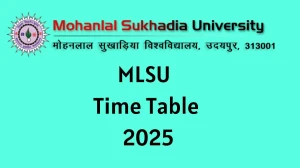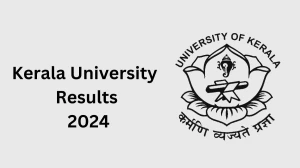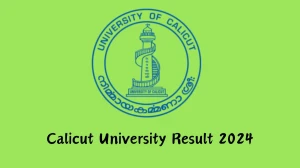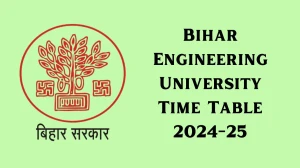- Rojgarlive »
- Education »
- ICSE Class 9 Performing Arts Syllabus 2024-25 at cisce.org Download Here
ICSE Class 9 Performing Arts Syllabus 2024-25 at cisce.org Download Here
by Keerthika
Updated May 13, 2024
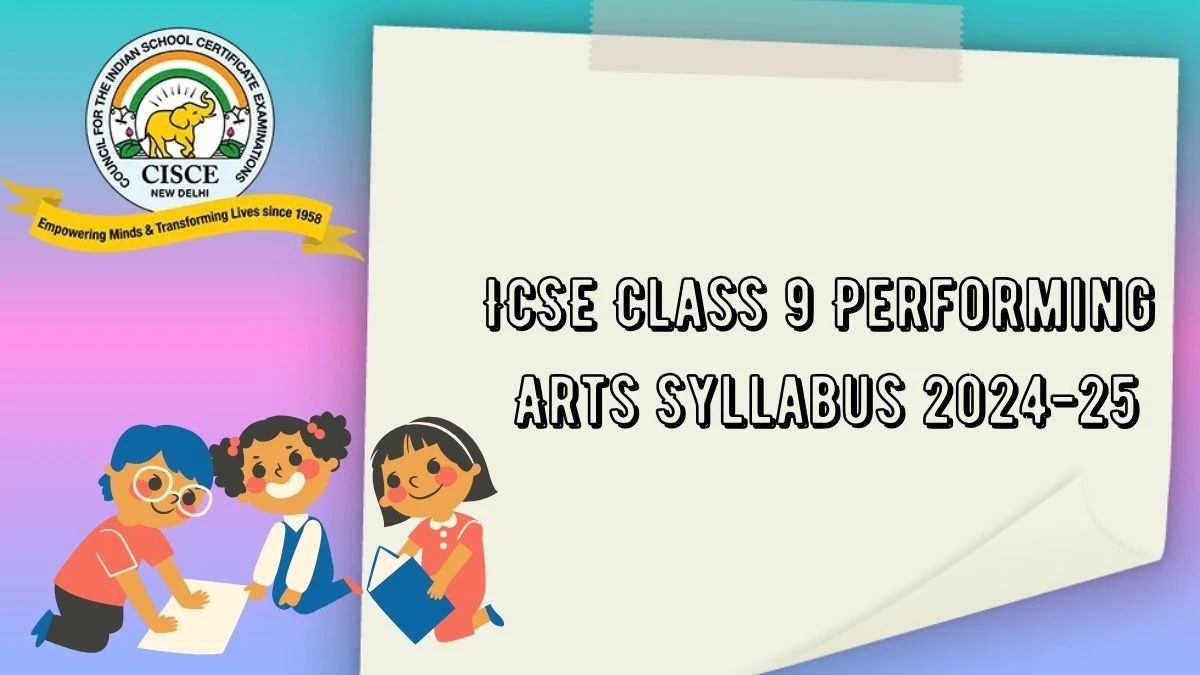
ICSE Class 9 Performing Arts Syllabus 2024-25 at cisce.org
The ICSE Class 9 Performing Arts syllabus serves as an elective subject aimed at fostering students' creativity and cultivating an appreciation for music, dance, and drama. Through this subject, learners delve into various artistic domains, refine their skills, nurture critical thinking abilities, and learn to articulate their creativity effectively. For further details, refer to the accompanying article.
Check - ICSE Class 9 Performing Arts Syllabus 2024-25
ICSE Class 9 Performing Arts Syllabus
|
Subject Code |
Subject Name |
Description |
|
91 |
Hindustani Music |
Explores the theory and practice of Hindustani classical music, including vocal and instrumental elements. |
|
92 |
Carnatic Music |
Focuses on the theory and practice of Carnatic classical music, another major Indian classical music tradition. |
|
93 |
Western Music |
Introduces students to Western music theory, notation, and performance techniques on instruments like piano or guitar. |
|
94 |
Indian Dance |
Delves into the rich history and techniques of a specific Indian classical dance style, such as Bharatanatyam, Kathak, or Odissi. |
|
95 |
Drama |
Explores the fundamentals of drama through acting techniques, script analysis, and basic stagecraft. |
ICSE Class 9 Performing Arts Syllabus Aims 2024-25
- To develop a perceptive, sensitive and critical response to music, dance and drama in its historical and cultural contexts.
- To stimulate and develop an appreciation and enjoyment of music, dance and drama through active involvement.
- To balance the demands of disciplined skills and challenging standards in an environment of emotional, aesthetic, imaginative and creative development.
- To develop performing skills, and so encourage a participation in the wide range of performance activities likely to be found in the school and community.
- To develop a co-operative attitude through the organisation and participation associated with music, dance and drama.
- To provide an appropriate body of knowledge with understanding, and to develop appropriate skills as a basis for further study or leisure or both. One of the following five syllabuses may be offered:
- Hindustani Music (91)
- Carnatic Music (92)
- Western Music (93)
- Indian Dance (94)
- Drama (95)
ICSE Class 9 Performing Arts General Paper Guidelines for 2025 Exams
There will be one paper of two hours duration carrying 100 marks and an Internal Assessment of 100 marks.
The syllabus is divided into three sections:
Section A - Vocal Music
Section B - Instrumental Music
Section C - Tabla
Candidates will be required to attempt five questions in all, two questions from Section-A and either three questions from Section B or three questions from Section C.
ICSE Class 9 Performing Arts Syllabus 2024-25
HINDUSTANI MUSIC (91) SYLLABUS 2024-25
|
PART 1: THEORY – 100 Marks SECTION A: HINDUSTANI VOCAL MUSIC |
|
1. (a) Non-detail terms: Sangeet; two main systems of Indian Music; Naad, Saptak; Thaat; Alankar; Raga, Janak-Janya Ragas and Ashraya raga; Vadi, Samvadi, Anuvadi, Vivadi; Aroha, Avaroha, Pakad; Chal and AchalSwara. Sthayi, Antara; Taan, Alaap; Matra, Vibhag, Taal, Avartan, Sam, Tali, Khali, Theka; Thah (Barabar or Ekgun), Dugun, Chaugun. (b) Detailed topics: Swara (Shuddha and VikritSwars), Jati (Odava, Shadava, Sampoorna), Laya (Vilambit, Madhya, Drut), Varna (Sthai, Arohi, Avarohi, Sanchari), Forms of Geet – Swaramalika, Lakshangeet, Khayal (BadaKhayal and ChotaKhayal), Dhrupad. 2. Description of the five ragas mentioned under ‘practical’ – their Thaat, Jati, Vadi-Samvadi, Swaras (Varjit and Vikrit), Aroha-Avaroha, Pakad, time of raga and similar raga. 3. Description of the five taals mentioned under ‘practical’; writing them in Thah and DugunTaal notation. 4. Knowledge of the musical notation system of Pt. V.N. Bhatkhande (Swara and Taal-lipi); writing ChotaKhayal, Swarmalika and Lakshangeet, Dhrupad (only Sthayi and Antara) in musical notation. 5. Identification of ragas with the help of given short Swara-vistar. 6. Life and contribution in brief of Tansen and Pt. V.N. Bhatkhande. |
|
PRACTICAL |
|
1. Singing and identifying Shuddha and VikritSwaras. 2. Idea of Laya; Vilambit, Madhya and Drutlayas. 3. Singing of 10 alankars in Dugun and Chaugun Laya. 4. Yaman, Khamaj, Kafi, Bhairavi, Alhaiya Bilawal - Singing of one Madhya laya khayal song in any three ragas as mentioned above (with alaaps and taans). Lakshangeet and Swarmalika in the other two ragas, One Dhrupad Geet in any one raga (Only sthai and antara); National Anthem - Jana Gana Mana and National Song - VandeMataram (notation is not required). 5. Padhant (Reciting): Thekas of the following five taals with Taali, Khali shown on hands: Teen Taal, Keharwa, Dadra, Ektaal and Chartaal; their Dugun also. 6. Identification of ragas |
|
SECTION B HINDUSTANI INSTRUMENTAL MUSIC (EXCLUDING TABLA) THEORY |
|
1. (a) Non-detail terms: Sangeet; two main systems of Indian Music; Naad, Saptak; Thaat; Alankar; Raga, Janak-Janya Ragas and Ashraya raga; Vadi, Samvadi, Anuvadi, Vivadi; Aroha, Avaroha, Pakad;Chal and AchalSwar. Chal and AchalThaat, Toda, Alaap; Matra, Vibhag, Taal, Avartan, Sam, Taali, Khali, Theka; Thah (Barabar or Ekgun), Dugun, Chaugun. (b) Detailed topics: Swara (Shuddha and VikritSwars), Jati (Odava, Shadava, Sampoorna), Laya (Vilambit, Madhya, Drut), Varna (Sthai, Arohi, Avarohi, Sanchari), Forms of Gat (Maseetkhani and Razakhani). 2. Description of the five ragas mentioned under ‘practical’ – their Thaat, Jati, Vadi-Samvadi, Swaras (Varjit and Vikrit), Aroha-Avaroha, Pakad, time of raga and similar raga. 3. Description of the five taals mentioned under ‘practical’; writing them in Thah and Dugun in Taal notation. 4. Knowledge of musical notation system of Pt. V.N. Bhatkhande (swara and Taal-lipi); writing Razakhani Gat (with Bols). 5. Identification of ragas with the help of given short swara-vistar. 6. Life and contribution in brief of Tansen and Pt. V.N. Bhatkhande. |
|
PRACTICAL |
|
1. Handling of the instrument; correct posture and finger movement. 2. Playing of 10 alankars in Thah, Dugun and Chaugun. 3. Yaman, Khamaj, Kafi, Bhairavi, AlhaiyaBilawal – Playing of one Razakhani Gat in all the ragas as mentioned above (with alaaps and todas). Dhun in any raga mentioned above. National Anthem-Jana Gana Mana and National Song – Vande Mataram (notation is required). 4. Padhant (Reciting) - Thekas of the following five taals with Taali, Khali shown on hands: Teen Taal, Keharwa, Dadra, Ektaal and Chartaal; their Dugun also. 5. Identification of ragas. 6. Playing of simple Bols like Da Ra Da Ra, Da Ra Dir Dir, Da Dir, Da Ra, etc. |
|
SECTION C HINDUSTANI INSTRUMENTAL MUSIC (PERCUSSION - TABLA) THEORY |
|
1. (a) Non-detail terms: Matra, Taal,Vibhag; Sam; Tali, Khali, Avartan, Theka, Kayada, Palta, Tihai, Mohra, Mukhada, Tukda, Kismen (varieties of Theka) and Peshkara. (b) Detailed topic: Laya (Vilambit, Madhya and Drut), Layakari (Thah, Dugun, Tigun and Chaugun), Origin and development of Tabla. 2. Writing in Taal-notation of the six Taals mentioned under ‘practical’; with their simple development; writing of Thekas in Thah, Dugun and Chaugun layakaris. 3. Basic knowledge of: Sangeet,Swara and Saptak, |
|
PRACTICAL |
|
1. Knowledge and practice of Vilambit, Madhya and Drut layas as also of Thah, Dugun and Chaugun, with the help of Tali, Khali and matras on hands while reciting Thekas of Taals prescribed. 2. Technique of producing main syllables of Tabla and Bayan (Varnas) like Ta, Dha, Ge, Kat, Tin, Dhin, Tita etc. 3. Playing of Thekas of the following six Taals with development: two kaayadas and its four paltas with tihai in Teentaal, One tukda in each Jhaptaal and Ektaal, one paran in chaartaal, two kismen each in Dadra and KeharwaTaal. 4. Accompaniment (Sangat) in Taals (Dadra and Keharwa). 5. Padhant (Reciting) - Thekas in Thah and Dugun. Simple developments of Taals mentioned in para (3), showing Taali, Khali etc. on hands. |
PART 2: PRACTICAL WORK IN MUSIC (WESTERN)
100 Marks
Candidates for the examination in Music (Western) will be required to have passed the Practical Examination of the Associated Board of Royal School of Music, Grade 4, or a more advanced grade or Grade 4 or a more advanced Grade of Trinity College, London or Grade 4 or a more advanced grade of London College of Music (or an equivalent examination approved by the Council).
|
Course Work |
|
The Practical work of candidates in Western Music in preparation for the practical examination of: - The Associated Board of Royal School of Music: Grade 4, or a more advanced grade, or - Trinity College, London: Grade 4 or a more advanced grade, or - London College of Music: Grade 4 or a more advanced grade or an equivalent examination approved by the Council), will be taken as the requirement for course work in Western Music. |
|
Final Test |
|
The practical examination of the Associated Board of Royal School of Music, Grade 4, or a more advanced grade, or Grade 4 or a more advanced Grade of Trinity College, London, Grade 4 or a more advanced grade of London College of Music (or an equivalent examination approved by the Council), will be taken in fulfilment of the final test for practical work in Western Music. |
|
Assessment |
|
The result of the practical examination issued by the Associated Board of Royal School of Music, Grade 4, or a more advanced grade, or Grade 4 or a more advanced grade of Trinity College, London, Grade 4 or a more advanced grade of London College of Music (or an equivalent examination approved by the Council) will be taken as the assessment of Part 2 of Western Music. |
|
TEMPLATE FOR ANALYSIS OF SYMPHONY Name of the Symphony - Key - Composer - Instruments used First movement: key, time signature, tempo direction Exposition: both themes, closing theme/coda. Brief description of motifs, important modulations and melody/harmony/rhythm. Development: modulations and treatment of themes Recapitulation: Keys used, the second subject remains in the tonic key, bridging passage, closing theme. Second movement: key, time signature, tempo direction Instrumentation used Themes, motifs, all important points of harmony, melody and orchestration Third & Fourth movements (the symphony may have less than three or more than four movements) as given in the above movements. All symphonic forms such as Sonata Form, Theme and Variations, Minuet and Trio, Scherzo, Sonata-Rondo, where applicable, must be described clearly. |
|
** TEMPLATE FOR ANALYSIS OF CONCERTO Definition, origin - Name of the Concerto - Key - Composer - Instruments and solo instruments used First movement: key, time signature, tempo direction Description of melodic and harmonic progression, key modulations, the role of the solo instrument, cadenza (if used), and Sonata Form (if used). Note: the cadenza format should be defined. Second Movement: key, time signature, tempo direction Description of melodic and harmonic progression, key modulations, the role of the solo instrument. Third Movement: key, time signature, tempo direction Description of melodic and harmonic progression, key modulations, the role of the solo instrument, cadenza (if used), and Sonata Form (if used). |
INDIAN DANCE (94) SYLLABUS 2024-25
There will be one paper of two hours duration carrying 100 marks and an Internal Assessment of 100 marks.
Candidates will be required to select one dance style from the following: Bharatanatyam, Kathak, Odissi, Kuchipudi, Manipuri and Kathakali. The coursework and assessment for the Internal Assessment shall focus solely on the dance style selected by the candidate. An overview of classical dance in India may be required, along with simple comparative studies between the different dance styles, for the written Theory paper.
|
PART 1: Theory – (100 Marks) |
|
Candidates will be required to attempt five questions out of eight questions. |
|
1. Identification of different classical dance styles in India. The aesthetic appeal of each, highlighting the distinctiveness of the individual styles, namely Bharatanatyam, Kathak, Odissi, Kuchipudi, Manipuri and Kathakali. 2. The mythological evolution of dance and an elementary understanding of important texts like the Natya Shastra, and storylines associated with classical dance in India. Also, an appreciation of the myths surrounding the lives of Ganesh, Krishna, Shiva, Vishnu, etc. 3. The sociological development of dance – its history, roots, growth and revival. 4. An understanding of the guru-shishya parampara (including the tradition and lineage associated with the chosen dance form only). 5. Prominent exponents of the various different classical dance styles listed above. 6. An understanding of the dance repertoire and musical accompaniment (for the chosen dance style only). 7. The relevance of dance in today’s world and the modern developments in dance |
|
PART 2: To be assessed internally by the School. Practical Work in Indian Dance - 100 Marks |
|
Course Work The practical section is divided into two parts: 1) Nritya 2) Abhinaya |
|
1. Nritya |
|
(i) The basic body stances and positions, the neck and eye movements of the chosen dance style. (ii) A minimum of 15 steps in Nritya to be executed in the 3 speeds of slow, medium and fast. (iii)An understanding of the different rhythms (Tal) and the ability to perform a particular Tal in a passage of dance. (iv) Recitation of the Bols (syllables) and the ability to present the spoken syllables in dance. (v) Individual presentation of a short Nritya item. |
|
2. Abhinaya |
|
(i) Knowledge of the Asamyuta (single hand gestures) and Samyuta (double hand gestures) used in Abhinaya. (ii) The Deva Hastas (Brahma, Vishnu, Shiva, Krishna, Ganesh, etc.) with their attributes. (iii)The DasavatarHastas (gestures depicting the 10 avatars of Vishnu). (iv) A basic knowledge of the Nava Rasas (nine emotions) used in dance, namely: a) Shringar – love (b) Hasya – mirth (c) Karuna – compassion (d) Roudra – anger (e) Veera – strength (f) Bhayanaka – fear (g) Bhibatsa – disgust (h) Adbuta – wonder (i) Shantam – peace (v) Individual presentation of a short item of Abhinaya |
DRAMA (95) SYLLABUS 2024-25
There will be one paper of two hours duration carrying 100 marks and Internal Assessment of 100 marks.
PART 1: THEORY – (100 Marks)
The syllabus is divided into two Sections:
Section A – Drama as Art
Section B – Technical aspects of Drama
Candidates will be required to attempt five questions in all, three questions from Section A and two questions from Section B.
|
SECTION A |
|
Six questions shall be set in this Section. Candidates will be required to evaluate and analyse material as part of a drama process. Resource material would be provided in each question in the form of extracted pieces from plays, themes, situations or printed visual sequences. The resource materials are expected to form stimuli that would be used by candidates to answer the question. Answers can be in the form of a written commentary and may be accompanied by sketches, diagrams and notes as required. Candidates would be permitted to creatively add dialogue to the stimuli provided for each question. Candidates will be expected to have an appreciation of the following elements: 1. Use of people, space and conflict in drama. 2. The function of the director. 3. The actor – basic technique (Stage positions; Body positions used by actors - in relation to the audience and to other actors; Turns and gestures; Movement and approaches; Entering and exiting; Handling of properties), body, voice and role. 4. The stage – its various parts and different types of staging (proscenium arch theatre, central staging, street theatre, folk theatre, puppetry). 5. Composition, picturisation, movement, rhythm, dramatisation. 6. Literature: no specific texts are prescribed, but candidates need to have studied some extracted pieces as examples, which may include Pygmalion, Galileo, A Doll’s House, Antigone and Improvise. |
|
SECTION B |
|
Four questions shall be set in this Section. Candidates will be expected to have working knowledge of the technical skills used by directors, actors, and designers (sets, costumes, make-up, lighting and sound). Questions will be set using resource material as a basis for technical design – candidates will be permitted to use sketches, notes and diagrams as part of their answers. Candidates will be expected to have an appreciation of the following elements: 1. Use of the stage and emphasis through set design, positions, compositions and movement; Blocking and its relation to the composition. 2. The production process; Rehearsals. 3. Equipment - from auditorium to backstage; Sets (including parts of stage equipment used in a set); Properties. 4. Lighting and sound – equipment and design. 5. Costumes and make-up (including design). 6. Stage management. 7. Different types of staging (as given in Section A) and their effect on technical aspects of a production. |
|
PART 2: To be assessed internally by the School. |
|
Practical Work in Drama - 100 Marks |
|
Course Work |
|
The practical section is divided into two parts - Acting and Stagecraft – both of which must be studied by candidates. 1. Acting: Candidates will be required to practise and perform as actors. This practical and performance may be undertaken either as acting 196 an original piece or acting a piece/extract from a play. The practical work of candidates will be assessed by the teacher as coursework. The teacher is free to assess the course work either on the basis of continuous assessment or on the basis of periodical tests. Where a candidate has personally taken part in the performance, video-recorded evidence and reviews may be submitted for assessment by the External Examiner. 2. Stagecraft: In addition to the course work on Acting, the candidates will be tested in one element of stagecraft by the teacher and by an External Examiner. Candidates will be required to choose one area from (i) Costumes, (ii) Makeup, (iii) Stage design including sets, (iv) Lighting, (v) Sound. Candidates should present designs prepared based on a play that has been developed as coursework during the year. Photographs, designs and video tapes may be submitted for assessment by the External Examiner where the candidate has prepared a design for performance. |
ICSE Class 9 Performing Arts Syllabus 2024-25? -FAQ
In case a student fails the ICSE board exam, he/she will be allowed to appear for the compartment exam in only one subject. If the marks meets the minimum criteria, he/she will be promoted else they will have to repeat an year.
For ICSE (Indian Certificate of Secondary Education) class 12th board exams, passing criteria may involve obtaining a minimum percentage in each subject and an overall aggregate percentage. Failing in one subject may lead to the need for a supplementary exam or reappearing in that particular subject.
